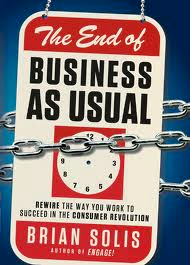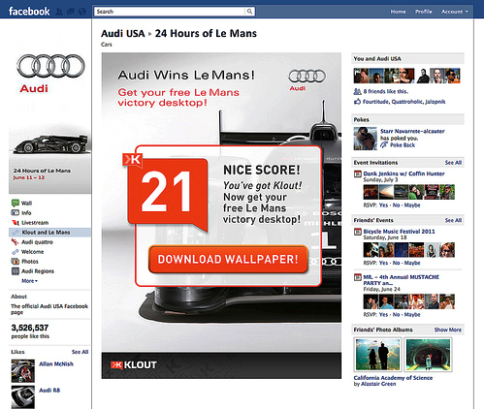 The consumer revolution is in progress. Do you know what part you play in it?
The consumer revolution is in progress. Do you know what part you play in it?
Do you realize that “digital Darwinism” (when society and technology evolve faster than a company's ability to adapt) is a threat to each and every business (including yours)?
Whether you're a marketer, a business professional or an entrepreneur, it is your job to figure out why consumers connect and how their social conversations influence your brand.
In his book, The End of Business as Usual, Brian Solis cautions that businesses that embrace and adapt to the revolution will survive the perpetual threat of digital Darwinism—and those that do not will die!
R.I.P., Blockbuster
Good examples of the effects of digital Darwinism are Blockbuster, Borders and Circuit City.
When Blockbuster filed for bankruptcy in 2010, analysts acknowledged that its predicament had more to do with the drastic shift in “how people watch video” than with their financial issues.
Blockbuster made the mistake of showing indifference to their customers' collective experiences and refusing to adapt to their needs.
Meanwhile, Netflix was already embracing the culture of innovation and turning home video into a delightful experience. Best of all, there were no strings attached, no late fees or due dates.
The moral of the story is that when businesses underestimate the power of the connected consumer or mistakenly presume to have control of the brand, it's only a matter of time before “the end of business as usual.”
Here's what you should know about Brian Solis' new book.
Author's Purpose

Brian Solis wrote this book to demonstrate how our digital culture is changing the landscape of business, consumerism and the workplace, and what YOU should do about it.
He hopes that the insights you gain from his book will teach you how to embrace new media in order to become a more competitive, more successful business.
Get World-Class Marketing Training — All Year Long!
Are you facing doubt, uncertainty, or overwhelm? The Social Media Marketing Society can help.
Each month, you’ll receive training from trusted marketing experts, covering everything from AI to organic social marketing. When you join, you’ll also get immediate access to:
- A library of 100+ marketing trainings
- A community of like-minded marketers
- Monthly online community meetups
- Relevant news and trends updates
What to Expect
The End of Business as Usual is all about a new era of business. An era in which information (social media) has drastically changed the landscape, disrupted markets and put the connected consumer in charge. It is an era in which businesses must either “adapt or die!”
With 20 chapters (283 pages) of weighty concepts and projections (all supported by research, quotes, statistics, graphs and passionate arguments), it's no surprise that the book gets a little intense at times. It should therefore be read in small, digestible chunks and with pen and paper handy.
You will be introduced to interesting concepts such as:
- Social consumerism
- The connected consumer
- “Youthquake”—how the Millennial generation has become a powerful force of influence and consumerism
- Your audience as an audience with audiences
- The co-creation of brands
- How digital influence creates a new “world order”

Favorite Chapters
#1: Youth quake
This fascinating chapter talks about the Millennial generation (those born between mid-1970s and the late 1990s) and why they should matter to every brand.
According to a study done by Edelman Digital in February 2011, this generation has an incredibly high level of brand loyalty. Specifically:
- 70% of Millennials feel that once they find a company or product they like, they will keep coming back
- 58% are willing to share more personal information with trusted brands
- 86% will share their brand preference online
- Nearly 20% of Millennials attended a brand-sponsored event in the last 30 days
- Of those who attended, 65% purchased the featured product
Beyond their growing influence as consumers, they are also assuming the role of self-ordained experts. Forty-seven percent of Millennials write about their positive experiences with companies and products online (on blogs and social media sites). On the flip side, 39% share negative experiences with their social networks as well.
The point is that no brand can afford to disregard the Millennial generation. They have money, they're influential and they're making decisions. The technology that is part of their DNA and their social network—even when they're sleeping—is always within arm's reach!
#2: An Audience With an Audience of Audiences
If you've ever presented at a live event, you're probably acquainted with this audience. As you speak, you notice that their laptops, tablets and smartphones—originally intended for note-taking—are now being used as a portal to share experiences with their fans or followers. You look up hoping to catch their attention, only to see eyes dipped into their devices and the battle for eye contact is lost!

Discover Proven Marketing Strategies and Tips
Want to go even deeper with your marketing? Check out the Social Media Marketing Podcast! Publishing weekly since 2012, the Social Media Marketing Podcast helps you navigate the constantly changing marketing jungle, with expert interviews from marketing pros.
But don’t let the name fool you. This show is about a lot more than just social media marketing. With over 600 episodes and millions of downloads each year, this show has been a trusted source for marketers for well over a decade.
The audience of today is not the audience we think we know. Today's audience has the ability to capture each moment through text, video, audio or still images and share them in real time with the hundreds or thousands of individuals in their social graphs.

This is the connected consumer. He or she is connected with other people in vast networks that are rich with interaction. Indeed, the social graphs that connected consumers create are increasingly interconnected, resulting in audiences that also have audiences of their own.
The good news is that your message will go well beyond those in the room and possibly spark a global conversation that might continue to reverberate for weeks.
Side note: A good example of how connected consumers can quickly spread their message to a global audience is the Facebook page Israel Loves Iran. Within days of its creation in March 2012, the page drew a huge worldwide audience (currently over 60,000 fans) including the support of over 1000 Iranians and 10,000 Israelis.
#3: The Co-creation of Brands
In this new social landscape that we live in, the customer plays a critical role in the dilution or reinforcement of a brand's identity. Each brand experience triggers an encounter that is rich with emotion. Updates, posts, tweets and other forms of self-expression become the platforms for these experiences.
The effects of these shared experiences on social media are extremely powerful. For example, here's what one airline executive discovered in an online conversation where customers were talking about his brand:
This airline sucks. When I checked in, I was told, “I'm sorry, there's nothing we can do about bumping you off this flight or losing your luggage.” Really? Well not only did you just lose a customer, I'm going to go out of my way to ensure that no one I know flies with you again.
When such experiences are shared on social networks and everywhere else (both online and offline), they act as guides for other consumers seeking input and direction from peers and experts.
So the pertinent question is not “Who owns the brand?” but rather “Who owns the customer relationship, or who owns the customer experience?” Therefore, as they set out to engage with consumers, brands should design experiences based on what they learn through customer sharing and customer reviews.
#4: Digital Influence and Social Capital
Influence is all the rage these days. Everybody is talking about it and services such as Klout, mBlast, Tweetlevel and so on, are busy measuring your level of digital influence based on your activity on Twitter, Facebook and LinkedIn.
By scoring influence, these services create a social hierarchy where you are ranked against other individuals based on your capacity to influence those who follow you. Social consumers receive a score based on what they do within social networks, who they know, and the activity that follows their interaction.

Brands have taken an interest in this concept because it represents an opportunity to engage connected consumers who are beyond the reach of traditional media. They can use this information to influence the behavior of “desirable consumers.”
Consumers on the other hand see this as an opportunity to earn higher scores, gain status, power and recognition and also earn free products, promotions or deals.
Personal Impressions
The End of Business as Usual is a very intense book. I read it over a period of two weeks and I find that I will have to revisit it in order to really grasp some of the details.
A lot of the information you will read is relevant and immediately applicable to your business brand; for example, the whole idea of connected consumerism. But other parts of the book may not be applicable right away, especially if you're a small business owner. An example is Chapter 18, which talks about business models and CRM.
Regardless, it's a good idea to become familiar with these concepts and then make a mental note to refer back to them at a later date when they are more relevant to your business.
One thing that bothered me though was the idea that our “always-on” culture (i.e., the intense need to be constantly connected with one another through social media) will eventually invade and disrupt our homes, our family time and dinner conversations and will finally redefine “acceptable behavior.” Maybe I'm just not ready for this to happen.
Overall, this is a fascinating book, rich with new data and research, but sometimes it's overwhelming because there's just so much to learn. If you read it in small chunks, mark it up with notes and refer to it often, you will get a ton of value from it.
As usual, Brian Solis has done a great job and Social Media Examiner gives this book a 4.5 star rating.
What do you think? Leave your questions and comments in the box below.
Image from iStockPhoto.
Attention Agency Owners, Brand Marketers, and Consultants

Introducing the Marketing Agency Show–our newest podcast designed to explore the struggles of agency marketers.
Join show host and agency owner, Brooke Sellas, as she interviews agency marketers and digs deep into their biggest challenges. Explore topics like navigating rough economic times, leveraging AI, service diversification, client acquisition, and much more.
Just pull up your favorite podcast app, search for Marketing Agency Show and start listening. Or click the button below for more information.

